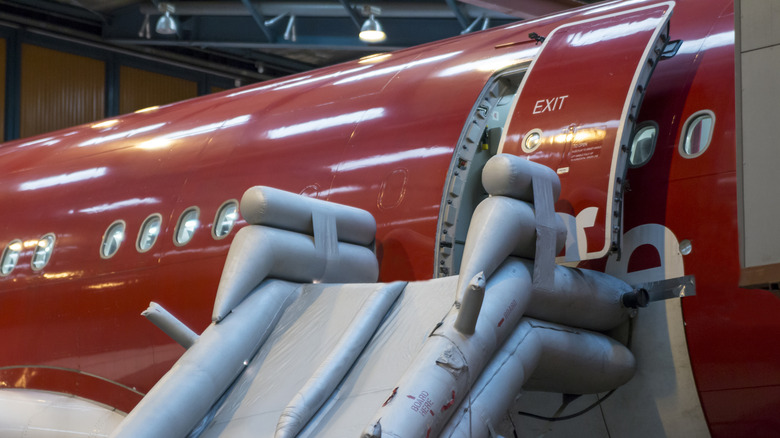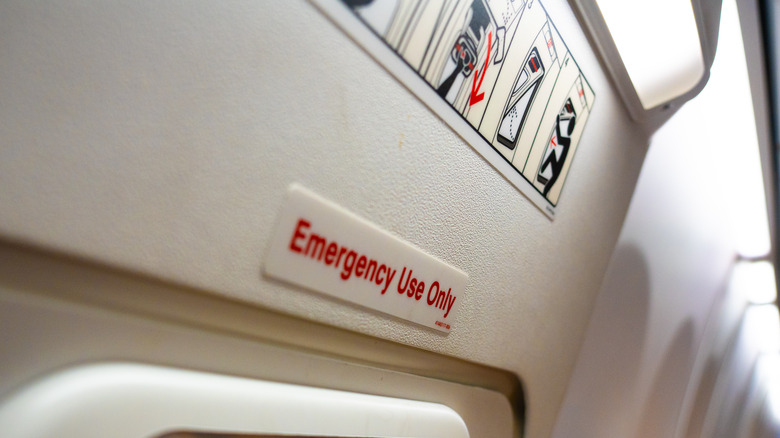Yes, Airplane Emergency Escape Slides Have Actually Been Used - Here's How They Work
Before an airline can take to the skies, it needs to pass a tough evacuation test. The crew must evacuate an entire aircraft in under 90 seconds, using only half the emergency exits, to meet the FAA's regulations. While the requirement might sound like an overkill, it is an important safety regulation to keep the skies safe. Apart from a highly skilled crew, safety equipment such as the emergency escape slide plays a massive role in expediting the evacuation process.
Remember the miracle on the Hudson River, where Captain "Sully" Sullenberger made an emergency water landing after the plane was damaged by a bird strike? The incident took place in January over the freezing cold waters of the Hudson. The emergency exit slides were deployed and doubled as rafts, giving passengers room to stay afloat until the rescue teams arrived. The quick thinking on the pilot's part and a swift rescue were the primary reasons no lives were lost on the Hudson, but the emergency escape slides, too, played a crucial role in avoiding injuries.
Emergency exit slides are designed to deploy instantly and withstand the elements during emergencies. The lightning fast deployment speed is a result of using a mixture of pressurized gases from canisters onboard and the ambient air, while their sturdiness comes from the use of high-performance materials. Let's take a deeper look at the ingenious working of these absolute lifesavers and revisit some notable incidents where they stood between life and death.
Emergency escape slides are designed to inflate instantly
Have you noticed the inward-bulging boxes on an airplane's gate? These compartments house the deflated and packed emergency escape slides. Airplane doors are equipped with a lever, which is disarmed during normal operations. During an emergency, the crew needs to engage the lever to deploy the slides when the gates are opened. Interestingly, as these levers are easy to engage, the cabin crew is required to check them after each landing to avoid accidental emergency slide deployments. This is one of many essential safety-related tasks carried out by crew, others include cross-checking doors and ensuring window shades are open for takeoff and landing.
When the gate is opened with the lever engaged, the emergency slides fall off the gate and start inflating partly with pressurized gas from the canister. The gas canisters can vary in size depending on the airplane; however, they gush out compressed gases at 3,000 psi (pounds per square inch) to quickly inflate the slide. The slide's ingenious design uses the Venturi effect to achieve rapid inflation. According to this principle, when a fluid is forced through a narrow outlet, it speeds up and its pressure drops.
The compressed gases from the canister passes through a narrow nozzle, creating a low-pressure area that opens valves and pulls in ambient air. This ambient air ultimately accounts for two-thirds of the slide's volume. The entire process only takes six seconds to complete, which is crucial for saving more lives during an emergency evacuation. The escape slides are made of strong carbon fiber and urethane-coated nylon fabric to withstand wear under extreme use. As these slides are often deployed in onboard fires, manufacturers spray the slides with fire-resistant paint.
Emergency exit slides have saved multiple lives
Emergency exit slides come in especially handy during engine fires that can happen for a variety of reasons. Fire can quickly spread on an airplane, and the evacuation needs to happen as soon as possible to minimize loss of life. One of the most notable incidents where a quick evacuation saved multiple lives happened at Naha Airport in Japan. On August 20, 2007, China Airlines Flight 120, flying from Taipei, landed at Naha Airport. What initially seemed like a normal landing quickly turned out to be a serious emergency. One of the fuel tanks started leaking, causing the right wing of the Boeing 737-809 to catch fire. The pilots ordered an emergency evacuation, and the crew immediately started evacuating passengers while the fire spread. The crew successfully saved all occupants only seconds before a massive fireball engulfed the entire fuselage. The emergency exit slides worked extremely well, leading to a rare case where no injuries or deaths were reported despite such a fast-spreading fire.
A similar incident occurred on Air France Flight 358, which overshot the runway, leading to an onboard fire. As this was a much larger A340, the evacuation was much more intense, but the emergency exit slides made it possible to save all 309 occupants.


